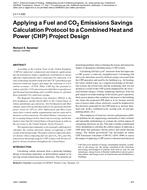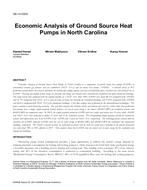Track: Research Summit
Sponsor: 6.5 Radiant Heating and Cooling
Chair: Devin Abellon, P.E., Member, Uponor, Apple Valley, MN
As building owners answer the call to establish more stringent energy-use standards for their new construction projects, design teams are looking beyond traditional HVAC solutions to systems such as radiant cooling. A radiant cooling design embodies the integration of architectural design and HVAC systems design with overall energy efficiency and comfort in mind. However, because these systems rely on hard exposed surfaces for heat exchange, designers are often faced with acoustical challenges. This session explores current research on the necessary balance between performance and environmental sound quality and explores different strategies used to create optimally comfortable spaces.
1. Effect of Acoustical Coverage and Air Movement on the Cooling Capacity of a Radiant Chilled Ceiling
Fred S. Bauman, P.E., Member, Center for the Built Environment (CBE), University of California, Berkeley, CA
Radiant slab systems have the potential to achieve significant energy savings. However, when applied in the ceiling, the exposed concrete may create acoustical challenges due to the high reflectivity of the hard surface. The purpose of this study is to conduct laboratory experiments for an office with varying coverage of free-hanging acoustic clouds and fans. Different fans configuration were tested against a reference case with no air movement. The tests conducted showed that the cooling capacity decreases as acoustical coverage increases. Adding fans brought an increase of the cooling capacity of 22-26% depending on fan configuration and acoustical coverage.
2. Effects of Horizontal and Vertical Sound Absorbers on the Cooling Capacity of Thermally Activated Building Systems (TABS)
Marcos Dominguez, Student Member, Technical University of Denmark, Lyngby, Denmark
As part of this study, the effects of horizontal and vertical free hanging sound absorbers on the cooling performance of TABS and on the occupants thermal comfort were measured in a full-scale TABS laboratory environment. The investigations have also been supported with Computational Fluid Dynamics (CFD) simulations to study the nature of the heat exchange between the TABS and the room when the sound absorbers are present.
Presented: June 26, 2017, 9:45-10:45 AM
Run Time: 60 min.
This is a zip file that consists of PowerPoint slides synchronized with the audio-recording of the speaker (recorded presentation), PDF files of the slides, and audio only (mp3) for each presentation.
Citation: ASHRAE Seminar Recordings, 2017 ASHRAE Annual Conference, Long Beach , CA
Product Details
- Published:
- 2017
- Units of Measure:
- Dual
- File Size:
- 1 file , 60 MB
- Product Code(s):
- D-LB17Sem24


